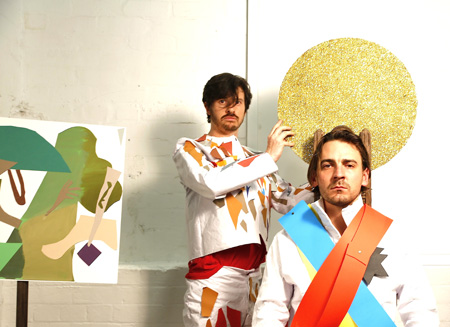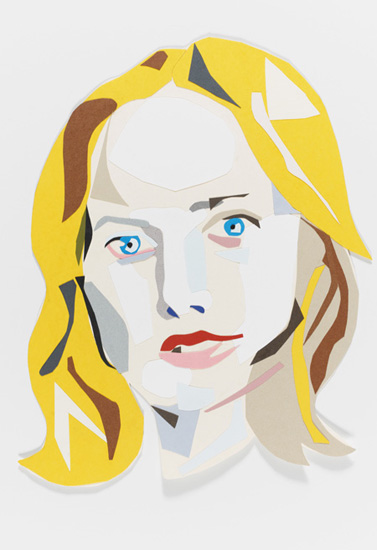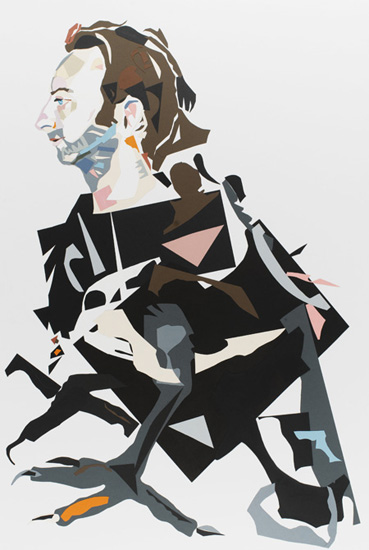Isobel Parker Philip charts her way through Oliver Watts‘s retelling of a tale…
In his show at Chalk Horse, Oliver Watts restages one of the lesser known fairytales compiled by the Brothers Grimm, The Sea-Hare, in a video work whose stylized mise-en-scène is constructed out of collaged ‘paper cut’ compositions. These paper cut compositions – some of which are exhibited alongside the video in the gallery and its adjacent studio – transcend the two-dimensional to become the raw material of a reimagined mythological landscape. They give shape to the space of enchantment.
Oliver Watts, The Sea Hare (image still), 2013, HD Digital Video (silent), 7:59 mins.
The Sea-Hare tells the story of a Princess who lives in a tower with twelve all-seeing windows. This tower is a folkloric Panopticon – a fictional prototype of the institutional architecture conceived by social theorist and philosopher Jeremy Bentham in the late 18th Century. A closed circular structure with an internal watchtower that can see into each of the inmates’ cells positioned along the building’s outer perimeter, the Panopticon enables total surveillance. It is an allegorical blueprint that maps a networked and institutionalized power structure mediated by the gaze.
Oliver Watts, The Princess, 2013. Paper Mask, 50×50 cm.
The story of the Princess in her tower anticipates the reciprocity between the design features of the Panopticon and the basic mechanisms of surveillance and control – a connection that is addressed in the exhibition’s catalogue essay by Dougal Phillips. To maintain sovereignty, the Princess must avoid marriage (thus relinquishing her power to her husband). And so she challenges her prospective suitors to a warped game of hide-and-seek. The man who can elude her gaze wins her hand while any candidate that fails is beheaded. The 100th contender is given three chances and enlists the help of the animal kingdom. His first attempts – hiding in a raven’s egg and the belly of a fish – prove unsuccessful. With the help of a fox he is transformed into a little sea-hare (a kind of sea slug with ears – or rhinophores if you want to get technical). The Princess is captivated by the sea-hare and has it brought to her in the tower. When she isn’t looking, he hides in her hair.
Oliver Watts, The Raven, 2013. Paper Cut, 100x150cm.
Taking refuge in her blindspot, the sea-hare is safe from her gaze. When the Princess realizes she has been tricked she breaks all the windows in the tower, demolishing the apparatus of control. The two marry and the sea-hare becomes a Prince.
Without prior-knowledge of the fable, it is difficult to follow its storyline in Watts’ retelling. There is no dialogue and certain plot points have been left out, such that the transition between scenes has more in common with the logic of Dada performance art than the linear progression of a fairytale (an association that finds encouragement in the paper props and costumes).
By masking the narrative thread of the story, Watts devises his own complex web of concealment and obfuscation that subtly echoes the thematic premise of the tale itself – the sea-hare isn’t the only thing that ‘hides’ here.
According to the catalogue essay, Watts is primarily concerned with mutable power structures and the revolutionary coup d’état that strips the Princess of her authority (casting himself as the fox, the mastermind behind the subversive act). His Prince is an insurgent, a far cry from the enfeebled figure in the suite of etchings David Hockney made in response to the fairytale in 1970. In Hockney’s work the Prince is cradled in the womb of the Princess. Watts recasts him as a revolutionary.
And yet, what I responded to in the work was not the performance of subversion but the way the thematic motif of concealment and invisibility is woven into the formal aesthetic language of the piece itself. For not only does Watts obfuscate narrative, he plays with the obfuscation of form.
In the paper cut compositions, figurative representation is teased out of collaged scraps of coloured paper. When we stand back the figures are obvious, but if we move in closer the work tips into abstraction. This oscillation between concealment and the reveal reiterates the push and pull between seen and unseen in the fairytale. It is as if the figures are hiding amongst the scraps of paper.
Each of the characters in the video – the Princess, the Prince and the fox – has a paper cut mask of their face (all of which are displayed on the wall next to the screen). Again there is the consonance between thematic content and form: a mask conceals and hides.
For Watts, The Sea-Hare is not simply a point of reference. It is an allegorical proposition. Re-enacting the narrative as a performance but also as an aesthetic scheme, he folds the fairytale in on itself.
The Sea Hare, Until March 18. Chalk Horse.




really great writing. Thank you.
Pingback: Collage – artist examples | deconstructed finger lime pie